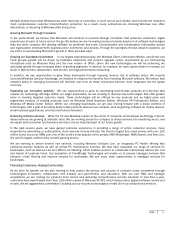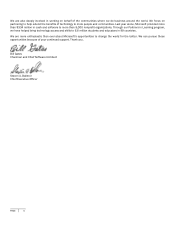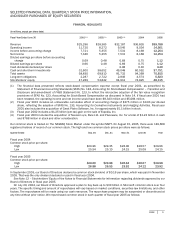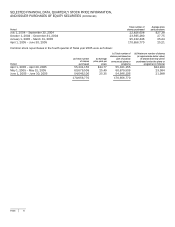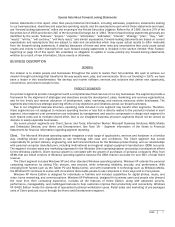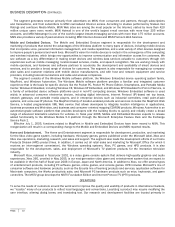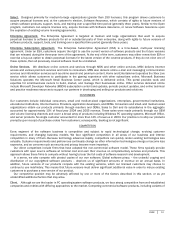Microsoft 2005 Annual Report Download - page 14
Download and view the complete annual report
Please find page 14 of the 2005 Microsoft annual report below. You can navigate through the pages in the report by either clicking on the pages listed below, or by using the keyword search tool below to find specific information within the annual report.
PAGE 13
Select. Designed primarily for medium-to-large organizations (greater than 250 licenses), this program allows customers to
acquire perpetual licenses and, at the customer’s election, Software Assurance, which consists of rights to future versions of
certain software products, support, tools, and training over a specified time period (generally three years). Similar to the Open
program, customers can acquire licenses only, acquire licenses with Software Assurance, or renew Software Assurance upon
the expiration of existing volume licensing agreements.
Enterprise Agreement. The Enterprise Agreement is targeted at medium and large organizations that want to acquire
perpetual licenses to software products for all or substantial parts of their enterprise, along with rights to future versions of
software products, support, tools, and training over a specified time period (generally three years).
Enterprise Subscription Agreement. The Enterprise Subscription Agreement (ESA) is a time-based, multi-year licensing
agreement. Under an ESA, customers acquire the right to use the current version of software products and the future versions
that are released during the three-year term of the agreement. At the end of the term, customers may either renew their ESA or
exercise a buy-out option to obtain perpetual licenses for the latest version of the covered products. If they do not elect one of
these options, then all previously covered software must be uninstalled.
Online Services. We distribute online content and services through MSN and other online services. MSN delivers Internet
access and various premium services and tools to consumers. MSN also delivers online e-mail and messaging communication
services and information services such as online search and premium content. Home and Entertainment operates the Xbox Live
service which allows customers to participate in the gaming experience with other subscribers online. Microsoft Business
Solutions operates the Microsoft Small Business Center portal, which is delivered online. This portal provides tools and
expertise for small-business owners to build, market, and manage their businesses online. Other services delivered online
include Microsoft Developer Networks (MSDN) subscription content and updates, periodic product updates, and online technical
and practice readiness resources to support our partners in developing and selling our products and solutions.
CUSTOMERS
Our customers include individual consumers, small and medium-sized organizations, enterprises, governmental institutions,
educational institutions, Internet Service Providers, application developers, and OEMs. Consumers and small- and medium-sized
organizations obtain our products primarily through resellers and OEMs. Sales to Dell and its subsidiaries in the aggregate
accounted for approximately 10% of fiscal year 2004 and 2005 revenue. These sales were made primarily through our OEM
and volume licensing channels and cover a broad array of products including Windows PC operating systems, Microsoft Office,
and server products. No single customer accounted for more than 10% of revenue in 2003. Our practice is to ship our products
promptly upon receipt of purchase orders from customers; consequently, backlog is not significant.
COMPETITION
Every segment of the software business is competitive and subject to rapid technological change, evolving customer
requirements, and changing business models. We face significant competition in all areas of our business and intense
competition in many of them. Because technology advances rapidly, competitors can quickly render existing technologies less
valuable. Customer requirements and preferences continually change as other information technologies emerge or become less
expensive, and as concerns such as security and privacy become more important.
Our direct competitors include firms that have adopted the non-commercial software model. These firms typically provide
customers with open source software at nominal cost and earn their revenue on complementary services and products. This
approach allows these firms to compete without having to bear the full costs of software research and development.
In a sense, we also compete with pirated copies of our own software. Global software piracy – the unlawful copying and
distribution of our copyrighted software products – deprives us of significant amounts of revenue on an annual basis. In
addition, future versions of our products compete with the existing versions, which our licensed customers may choose to
continue to use indefinitely. This means that future versions must deliver significant additional value in order to induce existing
customers to purchase a new version of our product.
Our competitive position may be adversely affected by one or more of the factors described in this section, or as yet
unidentified additional factors that may arise.
Client. Although we are the leader in PC operating system software products, we face strong competition from well-established
companies and entities with differing approaches to the market. Competing commercial software products, including variants of


